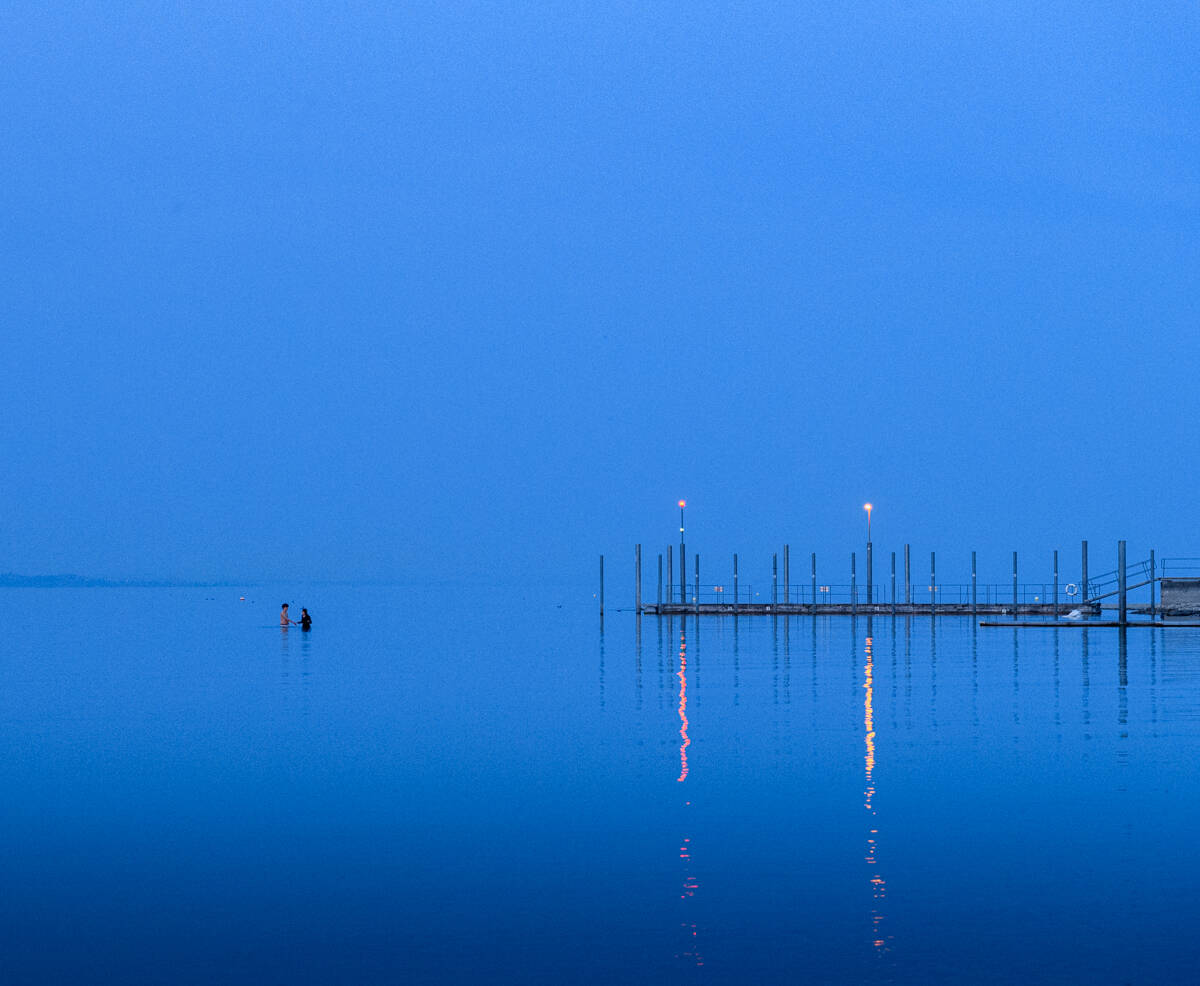A few days ago, I had the pleasure of recording one of the interviews for our upcoming Wildlife Photography Online Workshop. I was sitting in a cozy tree house overlooking the treetops, sipping a cup of excellent South American coffee, and chatting about photography with the great wildlife photographer Ondrej Prosicky. During our conversation, we touched on the subject of unforgettable wildlife encounters. For Ondrej, it was his first encounter with a lynx in the wild Finnish wilderness. For me? Probably my sighting of the majestic Crested Eagle about fifteen years ago. But just a few weeks ago, something else made my heart race – this stunning Agami Heron. Probably the most beautiful member of its family.
 Agami Heron (Agamia agami), Cuyabeno, Ecuador. NIKON Z 6 + TAMRON 50-400mm F4.5-6.3 A067 Z @ 400mm, ISO 1250, 1/500, f/6.3
Agami Heron (Agamia agami), Cuyabeno, Ecuador. NIKON Z 6 + TAMRON 50-400mm F4.5-6.3 A067 Z @ 400mm, ISO 1250, 1/500, f/6.3I wish you similarly happy encounters, not only during this Advent season, but beyond. May you always find good light – both in front of your lens and in your heart.
Recent Announcements
- Samyang AF 35mm f/1.4 P FE: The first lens of Samyang’s new Prima series, focusing on “Compact & Lightweight and Practicality.” The optical design consists of 12 elements in 10 groups (ASP 3, HR 1, ED 1). Focusing is possible from 0.3m (0.98ft). This autofocus lens is (so far) only compatible with the Sony E-mount. The weight is 470g (for comparison: the Nikon Z 35mm f/1.4 weighs 415g). According to the manufacturer, the lens is weather-sealed “at five critical points to safeguard against water droplets, light rain, snow and dust”. Future firmware updates can be done via the USB-C port on the lens mount. The price is expected to be around $550.
- Samyang AF 12mm f/2.0 RF-S: Samyang now enters the (previously forbidden) waters of the Canon RF mount. As the name suggests, this autofocus lens (with a linear STM motor) is designed for cameras with an APS-C sensor, on which it provides a 19mm full-frame equivalent field of view. With a length of 57.2 mm (2.25 in.) and a weight of 213 g (7.5 oz), this is a fairly compact lens. The optical construction consists of 12 elements in 10 groups (including two aspherical and 3 ED glass). The minimum focusing distance is 0.2 m, which opens up interesting close-up possibilities. The lens accepts filters with a diameter of 62mm. The price is $449.
- DJI Power Expansion Battery 2000: The existence of digital nomads is nothing new. But DJI also foresees the existence of digital hermits who can now spend long days or even months isolated from a power socket. This is because the existing DJI Power 1000 Portable Power Station has got a 2048Wh expansion. Up to 5 of these batteries can be connected together, giving the DJI Power 1000 a bottomless 11264Wh. Add to that the possibility of solar charging, and you can equip your new cave studio with, for example, a coffee maker and a TV. The only catch is that airlines have set a limit of 100Wh (27,027 mAh) for power banks, so you won’t be flying with it. The DJI Power 1000 costs $699, and the DJI Power Expansion Battery 2000 costs $899.
The Rumor Mill
Nifty thirty-five for Nikon
I know it doesn’t sound as good as nifty fifty, but for Nikon Z DX cameras, we are expecting to see a new 35mm f/1.7 AF from Viltrox. From what has been leaked about the lens, we should see 11 elements in 9 groups, a minimum focusing distance of 0.33m, an old school Nikon prime filter diameter of 52mm, an autofocus system, and a weight of just 170g. Most interesting is the rumored price of around $100.
Via Nikon Rumors
Global shutter in a Canon camera? Maybe next year.
The global shutter is a feature that only a relatively small group of photographers will truly appreciate, yet it’s something that manufacturers feel compelled to offer. Following the Sony a9 III, we may see a Canon camera with a global shutter as early as next year. After all, Canon has been toying with the technology since 2016, when it introduced the EOS C700 GS cinema camera for $38,000.
Some technical trade-offs, such as a higher base ISO, reduced dynamic range at lower ISO settings, and increased cost, may have kept Canon from bringing the feature to its still cameras. However, according to Canon Rumors, the debut of a global shutter in a Canon still camera could happen with a “high-volume” model, perhaps even an APS-C sensor. Will we see an EOS R7 GS? What about you – would you like to have a global shutter in your camera?
Via Canon Rumors
Good Deals and New Sales
While Black Friday and Cyber Week are officially behind us, plenty of interesting discounts are still available under the banner of holiday deals. Here are several cameras and lenses still with a steep discount.
Canon cameras:
- Canon EOS R5 was $3,400, now $2,800
- Canon EOS R6 Mark II was $2,500, now $2,000
- Canon EOS R7 was $1,500, now $1,300
Nikon cameras
- Nikon Z9 was $5,497, now $4,997
- Nikon Z8 was $3,997, now $3,497
- Nikon Z6 III was $2,497, now $2,197
- Nikon Zf was $1,997, now $1,797
- Nikon D850 was $2,997, now $2,197
Sony cameras
- Sony a1 was $6,498, now $5,498
- Sony a7 IV was $2,498, now $2,098
- Sony a7R V was $3,898, now $3,398
OM System camera
- OM System OM-1 Mark II was $2,300, now $1,800
Canon Lenses:
- Canon RF 28-70mm f/2 L USM was $3,100, now $2,800
- Canon RF 100-500mm f/4.5-7.1 L IS USM was $2,900, now $2,600
- Canon RF 24-70mm f/2.8 L IS USM was $2,400, now $2,100
- Canon RF 15-35mm f/2.8 L IS USM was $2,400, now $2,100
- Canon RF 14-35mm f/4 L IS USM was $1,400, now $1,300
- Canon RF 100mm f/2.8 L Macro IS USM was $1,200, now $1,000
Nikon lenses
- Nikon Z 14-24mm f/2.8 S was $2,497, now $1,997
- Nikon Z 24-70mm f/2.8 S was $2,397, now $1,997
- Nikon Z 70-200mm f/2.8 VR S was $2,697, now $2,197
- Nikon Z 35mm f/1.8 S was $847, now $597
- Nikon AF-S NIKKOR 28mm f/1.4E ED was $1,997, now $1,397
- Nikon Z MC 105mm f/2.8 VR S Macro Lens was $1,047, now $847
- Nikon Z 400mm f/4.5 VR S was $3,247, now $2,997
- Nikon Z 600mm f/6.3 VR S was $4,797, now $3,997
- Nikon Z 800mm f/6.3 VR S was $6,497, now $5,697
- Nikon Z 400mm f/2.8 TC VR S was $13,997, now $12,997
- Nikon Z 600mm f/4 TC VR S was $15,497, now $14,497
Sony lenses
- Sony FE 24-70mm f/2.8 GM was $1,698, now $1,498
- Sony FE 24-105mm f/4 G OSS was $1,298, now $1,098
- Sony FE 70-200mm f/2.8 GM OSS was $1,998, now $1,798
Other Pages of Interest
At the age of 86, Josef Koudelka has released a new book of panoramic photographs called Ruins. Like some of his other series, this work focuses on landscapes shaped by human influence – this time, however, completely devoid of human presence. The monumental remnants of long-lost civilizations were captured by Koudelka between 1991 and 2015. In addition to the book, you can experience these photographs in person at the Museum of Decorative Arts in Prague, where they will be on display until March 30, 2025.
If you’ve been waiting for a successor to the Nikon D500 – a pro-level camera body with advanced features and an APS-C sensor – you may be waiting in vain. PetaPixel interviewed Takashi Aihara, Department Manager of Nikon’s Imaging Business Unit, who hinted that APS-C cameras and lenses are and will likely remain an entry point for amateurs and entry-level photographers who have outgrown the capabilities of their smartphones and want a “real camera.”
Looks like the night of May 10 this year was truly magical. At least for aurora photographers. The phenomenon that is usually seen in the polar regions was photographed as far south as Italy, the Canary Islands, and California. Of course, it was not only from this day and these locations that the best photos of the 7th edition of The Northern Lights Photographer of the Year were taken.
The Royal Society Publishing Photography Competition highlights photographs that reveal fascinating scientific phenomena and use their visual appeal to make science more accessible to the general public. On the competition website, you can explore the best images in categories such as Astronomy, Behavior, Earth Science and Climatology, Ecology and Environmental Science, and Microimaging. I personally believe that popularizing science is almost as important as doing science. So take a moment to look, wonder, and be amazed.
Photo Theme Challenge, Week #79
Last week’s theme was emptiness, and you can see the results in this thread. Thank you to everyone for your submissions! This week’s theme is rain, and you can submit your results in this thread by Saturday, December 14, 2024!
Week #78 Results
Let’s check out some of the shots we received for the “emptiness” theme, starting with DL84’s photo:

An image with large areas of deep blue, empty space make the subjects stand out even more.
For an even emptier photo, we have this image from Andrew Gusew:

There are hardly any tones here except pure black and pure white. Andrew shows how emptiness in a photo can also give a sense of loneliness and isolation. A big part of photography is to convey emotions, and this photo certainly qualifies.
Finally, we have vidmarko’s photo:

This abstract architectural photo is interesting because the emptiness in the frame is complemented by the lack of immediate meaning or logic in the photo. Very nice work, vidmarko!
Thanks everyone for submitting their photos in the challenge, and we hope to see more next week in the rain theme.

 2 weeks ago
46
2 weeks ago
46





 English (US) ·
English (US) ·